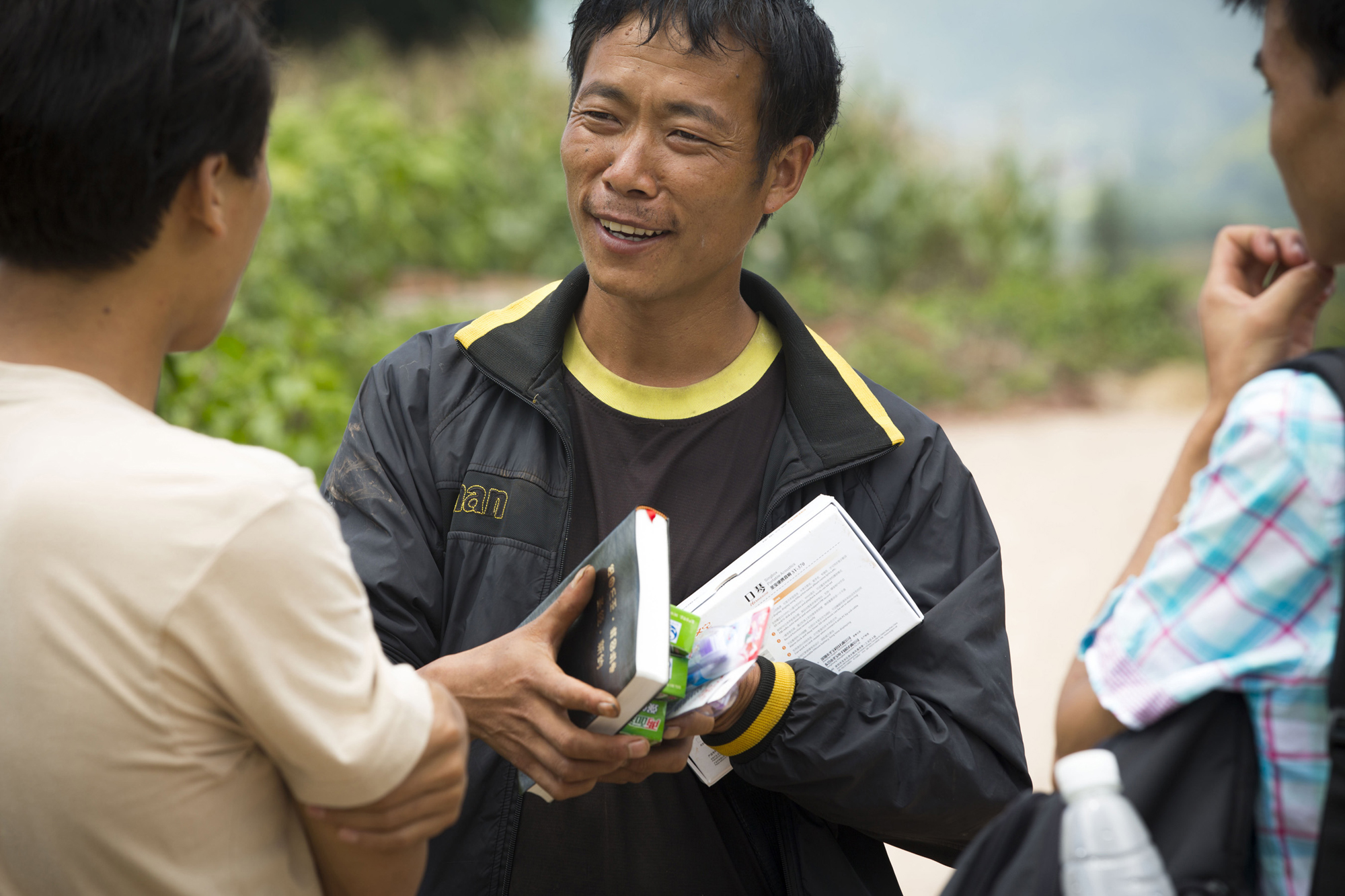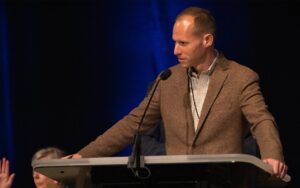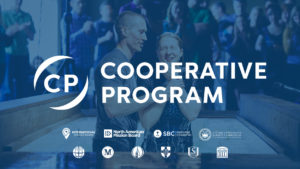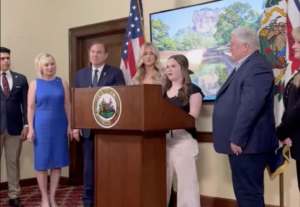
[SLIDESHOW=39240,39241,39242,39243]EDITOR’S NOTE: This year’s Week of Prayer for International Missions in the Southern Baptist Convention was Nov. 30-Dec. 7 with the theme of “One Sacred Effort — Find your place in God’s story” from Matthew 28:19-20 (HCSB). The Lottie Moon Christmas Offering for International Missions in tandem with Cooperative Program gifts from Southern Baptist churches support approximately 4,800 international missionaries in seeking to fulfill the Great Commission. Gifts to the Lottie Moon offering are received through local Southern Baptist churches or online at imb.org/offering, where there are resources to promote the offering. This year’s goal is $175 million. Jon Gerwig*, included in this story, is among the featured missionaries in this year’s Week of Prayer.
EAST ASIA (BP) — Along the side of a mud-packed mountain path, four East Asian believers sit under the shade of tall bamboo with a small, stooped woman in the traditional dress of her minority people group.
The sounds of a radio program ring out from an MP3 player stowed in one of their backpacks, and her eyes light up as she listens to Bible stories told in her mother tongue.
It is not common that a radio program would be broadcast in her language. Her Iron Pea* people group speaks six dialects, each distinct and all incomprehensible to those who speak the national majority’s trade language.
 The four believers are translators, working to interpret the book of Luke into the woman’s dialect. Once a month they travel into the community, testing what they have translated — while also witnessing to people.
The four believers are translators, working to interpret the book of Luke into the woman’s dialect. Once a month they travel into the community, testing what they have translated — while also witnessing to people.
Back in the city, a headphone-clad Li Chang* sits at a large Mac computer watching audio levels bounce up and down on the screen. Luo Jie* sits on a stool in the next room, carefully reading a passage from 1 Corinthians into a microphone. These small rooms have been transformed into a makeshift recording studio, complete with mattresses leaning against the walls as sound panels.
The ministry of Li Chang, an Iron Pea believer, is to record the radio program that played from that MP3 player in the mountains. Luo Jie is an Iron Pea believer who often provides voice recordings. Together with IMB missionaries, other national believers and Christian partners, they are recording Scripture and resources in the Iron Peas’ heart language, including oral Bible stories, original worship songs and testimonies.
All this culminates in a new method of ministry called “Scripture planting.”
Heart value
Scripture planting was developed by IMB missionaries in East Asia working to reach minority peoples like the Iron Peas with the Good News of Jesus. Scripture planting integrates the crafting of oral Bible stories with real-time church planting, evangelism and discipleship. This provides quicker development of resources, such as worship songs and recorded testimonies, as well as Bible translation.
At its core is the use of heart language, “the language in which identity, values, core beliefs and so forth — including religion — are typically learned, acquired [and] held,” said Grant Lovejoy, International Mission Board’s director of orality strategies. (Please see related story on the “StoryTogether” initiative below.)
Both Jon Gerwig* (See additional feature on Gerwig following this story.) and Bradford Wotzke* moved to East Asia with their families in 2004, becoming some of the first IMB missionaries to work with the Iron Peas in this city. The people group of more than 3 million had no known churches and only a handful of believers. The Iron Peas, who primarily worship the spirits of their ancestors, are considered an “unreached people group,” meaning less than 2 percent of them are evangelical Christians.
In the past, this country’s majority people group oppressed the Iron Peas, resulting in violent battles. Most retreated high in the mountains, where their poverty level is high and their education level is low, to eke out a secluded living as farmers. Tension still exists between the groups, and many Iron Pea people, particularly women and children, do not speak the trade language.
“You’re just spinning your wheels if you’re not reaching the people in the language of their heart,” Gerwig said. “… So you want to reach women, you want to reach children, you want to reach people in their moment of need in their heart? It has to be in their heart language.”
Beginning scripture planting
As Gerwig, Wotzke and other IMB missionaries began working with the Iron Peas in 2004, they planned to utilize Scripture resources — biblical stories and other materials that foster evangelism, discipleship and church planting — in their ministry.
However, not many Iron Pea language resources were available at the time, so they had to be developed. With the help of local believers, one of the first resources they translated was the “Creation to Christ” story, a 10-minute chronological story that explains the Gospel simply.
An important development came in 2005, when a Great Commission Christian partner completed the Iron Pea New Testament, and the Old Testament translation has been underway since. The Bible is necessary to grow the church and believers, Wotzke emphasized, but getting the entire Bible into a heart language typically takes several decades.
“We can’t wait 40 years,” Wotzke said. “How many people die every day in that people group? How many people are dying over that number of years?”
Bo,* an Iron Pea believer and translator, explained they once thought they must have the entire Bible translated before they could use it, but now take a more practical approach.
“We considered our translation work like cooking for different sets of guests,” Bo said. “… Some guests may be very busy and cannot wait for the entire meal. We must cook our dish (the translation work), finish each dish and let each group of guests come, eat and leave.”
First believer, first church
The missionaries’ ministry goal is not just to see new Iron Pea believers, or even new disciples — but to see new churches started.
“We know that no matter how well we adapt culturally to the lifestyle here, how well we understand their culture, we will always be an outsider,” Gerwig said. “And for there to be a movement, a massive movement of multiple churches being started, thousands upon thousands of Iron Peas coming to faith — it’s going to take that Gospel message coming from an insider.”
But finding that first “insider” was difficult. For 16 months, Gerwig and his team did not see any Iron Pea people come to faith.
During that time, though, more resources were being created to reach Iron Peas. In 2005, the missionaries developed the idea of a radio program, filled with Gospel-centered content, broadcast in the Iron Pea language. With the help of several Great Commission Christian organizations and national partners, the radio show premiered in 2007.
To help build the program’s audience, missionaries, nationals and volunteers from the U.S. trekked through Iron Pea areas, handing out radios and teaching villagers how to tune into the radio broadcast each night. Their strategy now includes equipping volunteers and other non-Iron Pea speakers with MP3 players loaded with the Creation to Christ story.
“Anybody, whether you have any language or not, can walk into an Iron Pea village, turn the speaker set on … and 10 minutes later, people have heard the story,” Gerwig said.
Finally in 2006, Gerwig saw the first believer among the people group, a man named Solomon.*
Solomon became an outspoken witness in his community — by 2007, there were nine believers in his village. A few months later, 80 from his village and 60 from another had put their faith in Jesus. Over the next several months, Gerwig and his team trained these new believers in a basic, short-term discipleship plan, and in late 2007, the first church among the Iron Pea people was started.
Since the first church was established, the Gospel has spread throughout Iron Pea communities. Multiple “second generation” churches, which are churches started by Solomon’s church, and several third generation churches have been started. Today, there are 28 churches and approximately 3,000 believers among the Iron Peas.
2020 vision
Now is a unique time in the Iron Pea people’s history, Gerwig said.
“There are more Iron Pea believers seeking to reach the Iron Peas, and that’s something that’s never happened before.” Iron Pea believers are an integral part of developing Scripture resources, producing the radio program and strategizing ways to reach their own people.
Gerwig said he is thankful God has allowed him and his team to be a part of this and believes that future missionaries to this people group will come from among the people group itself. The team’s vision is that by 2020, each of the six Iron Pea dialect groups will have at least fourth generation churches among them.
Others can be a part of the effort to share the Gospel with unreached people groups like the Iron Peas around the world, Gerwig noted.
“When you give to the Lottie Moon Christmas (Offering), you are helping to plant churches among the Iron Pea people — there’s no way around that at all, nor should there be,” he said. “Your money helps start churches.”
Please see additional related stories below.
**************
First believer opens door to Gospel among people group
EAST ASIA (BP) — Jon Gerwig* was discouraged — it had been 16 months of sharing the Gospel, but not one person had put their faith in Jesus.
Gerwig, an IMB missionary, came to East Asia in 2004 to work with the Iron Pea* people group, which had no known churches and only a handful of believers. He and his coworkers use a new method of ministry called “Scripture planting,” which integrates Bible translation with real-time church planting, evangelism and discipleship.
Although they used resources such as a chronological Gospel storying and Bible recordings, “it didn’t seem like anyone was interested,” Gerwig said.
In 2006, Gerwig took a team of Southern Baptist volunteers to share the Gospel in an Iron Pea county — but the first day, no one responded. The next morning, the team prayed together and set out into a new area.
As they walked along a mountain path, they met a man named Solomon.* He asked the group what they were doing. Gerwig told him they were just climbing the mountain and learning about the local culture.
“He looked at us straight away and said, ‘That mountain behind me is boring, and besides, I think you came here to see me,'” Gerwig recalled.
Solomon invited the group into his home, and there they shared the Gospel story — and he immediately expressed a desire to put his trust in Jesus. Solomon then shared his own story.
“[Solomon] knew that there was a most high God, but he didn’t know who He was,” Gerwig said. “So every day for 20 years he had been praying, ‘God, send somebody to me to explain who you are.’
“And he looked at me and he said, ‘And God answered that prayer today when he sent you to me.'”
As they talked, interested neighbors crowded around to see the visitors. Solomon did not waste time — he told the crowd, “This is my friend from America. Now, look at me. I have a story I want to tell you,” Gerwig recalled, and Solomon shared the Gospel.
Over the next several months, Solomon led his wife and one of his children to faith in Jesus, and by the beginning of 2007 there were eight believers in his village. But the village’s witch doctor saw these changes as a threat.
“He told Solomon that if he didn’t stop sharing [the Gospel], within three days he was going to put a curse on him, and Solomon would die,” Gerwig said. “Solomon didn’t stop sharing.”
On day four — after he should have died — people in the village asked Solomon, ‘What do you know that we don’t know?’ Again, Solomon shared the Gospel, “this time with more power,” Gerwig said, and 80 people believed in Jesus.
On day five, people from a nearby village came to Solomon and asked the same question. Again, Solomon shared — and 60 people believed.
Over the next nine months, Gerwig and his team trained these new believers in a basic discipleship plan and, in September 2007, the first church among the Iron Pea people was started.
Since then, the Gospel has spread throughout Iron Pea communities. Multiple “second-generation” churches, which are churches started by Solomon’s church, and several third-generation churches have been started. Today, there are 28 churches and approximately 3,000 believers among the Iron Peas.
“The power of the Gospel was apparent in the life of Solomon,” Gerwig said.
**************
‘StoryTogether’ initiative seeks to put Scripture in hands of people groups
EAST ASIA (BP) — Can you imagine going through a difficult time, a tragedy — without the consolation of the Bible’s promises? Without the courage, comfort and hope Scripture provides believers when they desperately need it?
Around the globe, thousands of people groups (an ethno-linguistic group with a common self-identity) have little or no written Scripture. When they “walk through the valley of the shadow of death” (Psalm 23:4), they know of no biblical hope to cling to, no reassurance or promise to rely on from God’s Word.
In an effort to ensure that every International Mission Board-engaged people group has adequate Scripture resources in their native (“heart”) language, IMB started the Strategic Scripture Resource Initiative in 2013.
As of September 2014, IMB field personnel reported engaging 179 people groups and population segments that do not have even one book of the Bible printed in their heart language. IMB teams reported working with an additional 104 people groups that have only portions of Scripture, and 200 people groups that have only a New Testament printed in their heart language.
Pressing scripture needs
Addressing the need for Scriptures does not mean IMB will become a Bible translation agency. There are several Great Commission Christian partner organizations already doing that work, which takes decades and the expertise of professional linguists. However, IMB’s focus will be helping missionaries meet short- and intermediate-term needs for people groups to have access to Scripture.
That may include finding ways to get written Scripture to some people groups. Another way to meet those short- and intermediate-term needs is through Scripture resources, such as the JESUS Film and oral Bible stories, which are rooted in Scripture.
An IMB best practice for addressing pressing Scripture resource needs is the “StoryTogether” process. This method produces high-quality oral Bible stories in people’s heart language, “the language in which identity, values, core beliefs and so forth, including religion, are typically learned, acquired [and] held,” said Grant Lovejoy, IMB’s director of orality strategies.
In years past, IMB mainly crafted stories in the people’s national or regional language. But recent research has shown that using heart languages makes a stronger impact and is more likely to be reproduced orally, Lovejoy said.
Multiplying efforts, multiplying believers
Since 2009, IMB has been refining the StoryTogether process through several pilot projects across the world. One pilot project in West Africa grew from a ministry to national truck drivers. As the drivers became believers, they became burdened to share their new faith with those they encountered in their travels — which required Bible stories in a variety of languages.
Using the StoryTogether model, missionaries trained 23 national pastors and church planters, many of whom were truck drivers. Through several workshops spread over six months, they developed and recorded 18 oral Bible stories each in four different languages — a total of 72 stories.
In the past, IMB missionaries typically translated stories with a national partner’s assistance, but StoryTogether emphasizes the importance of heart-language speakers crafting the stories themselves. They can translate stories much better since they know their own culture’s storytelling style best — the missionary coaches the process.
As illustrated in West Africa, StoryTogether also allows multiple languages to be translated simultaneously in one workshop, instead of just one language. There is a “tremendous advantage” to doing this, Lovejoy said, because participants can instruct and inspire each other, while also learning from each other’s successes and challenges.
“As we look at needs around the world, the opportunity to provide Bible stories in multiple languages through the same event is a multiplication of our effort, of our impact that we think is very wholesome,” Lovejoy said. “It’s good stewardship of the time of our trainers and the money involved.”
StoryTogether also differs from past IMB story crafting methods because of systematic, intentional testing of the translations in the local community as they are being developed, instead of after the translation is formed. This testing not only helps the stories be sound and accurate but allows for sharing of the Gospel. If the testing identifies flaws in how they have told the stories, the teams revise and test them again. StoryTogether projects also include a third-party evaluator who further assures the accuracy and quality of the stories.
Through the West Africa pilot project, the national pastors and church planters, along with others they trained in storytelling, have led more than 1,000 people to faith within about six months.
“The existing churches have been strengthened as they’re getting better understanding of the Bible and God. They have seen multiple generations of churches planted using the stories,” Lovejoy said. “… In addition, they have reported that discipleship has really been revolutionized through having Scripture in this form.
“We just believe that as Southern Baptists understand the plight these people are in, and how powerful it could be if [people groups] could have even 40 or 50 of the most important biblical stories in their language — what a huge lift that could give them in understanding the Gospel, in coming to faith, hanging on to God in times when they’re troubled,” Lovejoy said.
Learn more about StoryTogether at storytogether.imb.org.
*Name changed
Watch a video of Jon Gerwig* describing how his team uses the latest technology to get the Scripture in the hands of a minority people group in East Asia:
[VIMEO=95998184]
















